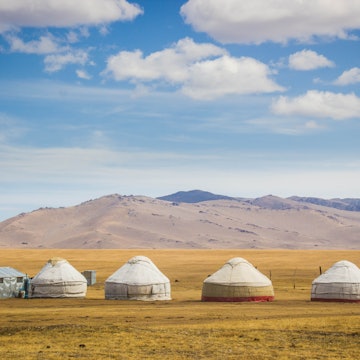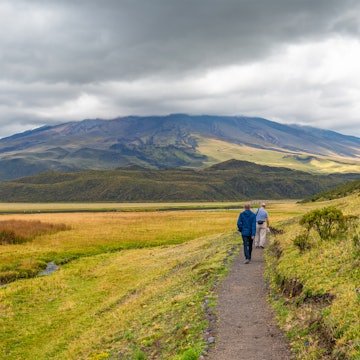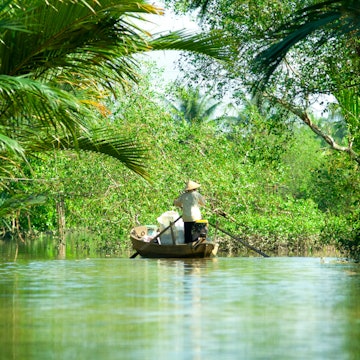
Top tips for spotting animals: a guide to watching wildlife around the world
Mar 2, 2022 • 6 min read

Whether it's a Bengal tiger or a bird in your back yard, here are some useful tips to help you on your search for the wildlife of the world. Sourabh Bharti / Getty
Birdwatchers and other species of travelers with a passion for watching wildlife are a breed apart. Millions of them migrate across the globe every year in the hope of a sighting, spending serious money as they go. The thrill of seeing an animal in its natural habitat, however fleetingly, has turned wildlife tourism into a multi-billion dollar division of the travel industry.
You don’t need to pay big bucks for Big Five bingo in Africa to partake, nor set off on an extreme quest to, say, the far-flung frontiers of China in search of a spoon-billed sandpiper or the misty lowlands of Ecuador on the trail of the stub foot toad.
The natural world is full of wonders, wherever you travel – you just need to know what to look for. Here are tips to increase your chances of spotting something every time you stop to take a proper look.

1. Don’t destroy the thing you love
This is the most important rule of all. It’s easy to have a negative impact on animals and the environment if you approach the task in a thoughtless manner. But you can enjoy an encounter in the wild in an ethical way by following a few simple rules on every trip, including:
Keep your distance.
Never feed wild animals.
Don’t interfere with their natural behavior at any time.
Adhere to the principles of ‘leave no trace’, which seek to protect areas of wilderness for the benefit of all.
The best places to see tigers in the wild

2. Do a bit of research on animals and their habitat
A little knowledge goes a long way. It’s not just about deepening your appreciation of what you might see (although that is a worthy goal); insight into the lives of animals gives you a basis for making smart decisions that could prove the difference between a sighting and a no-show.
Before you set foot outside, read up on your subject – learn about animals’ habitats and habits; where they sleep, feed and breed; how the seasons affect their behavior, and how they interact with other species. This information is enriching in itself, but it is also of practical use when you’re searching for an elusive creature.
If you want to go deeper, learn to recognize the clues animals leave behind. Many large mammals, for instance, clear pathways through undergrowth over time, while other animals leave more subtle signs of their presence on the ground, on or near trees, or by the water’s edge.
Tracking animals is an arcane branch of knowledge unto itself; you don’t need to be able to name a species from a glance at its scat (droppings), but a basic grasp of how to interpret marks left in mud, sand or snow can also inform your search.
The world's best places to swim with whale sharks

3. Right time, right place
Bad news, lazybones: many animals observe antisocial hours. Most humans are woefully out of sync with the rhythm of the natural world, where activity levels peak at dawn and dusk. To give yourself the best chance of seeing something, rise before the sun and linger as the light leaches from the evening sky.
One creature you might well see abroad at these bleary-eyed, yawn-inducing times of the day is the photographer, a species tempted into the open by the soft light of the ‘blue’ and ‘golden’ hours on either side of sunrise and sunset. So this is a great time for taking pictures of wildlife as well as spotting it.
Places where one form of habitat or terrain transitions into another are always a good bet for a stakeout – riverbanks, estuaries and shorelines are prime examples of this, but there are other borderlands where animals reliably appear: the point where a meadow meets woodland, for instance, offers food and shelter.
These nine wildlife webcams offer access to your favorite animals

4. Blend into your surroundings
Leave that Hawaiian shirt on the hanger – you won’t be needing it. Even at their most discreet, humans are large, loud, smelly creatures; don’t compound the problem with a wardrobe that makes you as conspicuous as a flamingo on a salt flat.
Animals sense your presence long before you’ve settled down for a vigil, but a sober choice of clothing still helps to lessen your impact. Go for muted black, brown, green or grey clothes that blend into the background as appropriate and avoid garments that make a noise – now is not the time to unpeel umpteen strips of Velcro.
Choice of position is important if you’re trying to lie low. Look for somewhere downwind of the area you’re observing that offers a degree of camouflage – ideally, inside a proper hide, but otherwise concealed by shrubbery, behind a stand of trees or another obstacle that shields you from the animals’ direct line of sight.
Serengeti's Great Migration: the world's ultimate wildlife spectacle

5. Be quiet, stay still
Animals possess the sort of superpowers that would make Batman blush. Some species can hear a proverbial pin drop; others can see tiny objects from miles away; still, more can detect the faintest whiff drifting on the breeze.
From high up in a tree, an owl can hear a mouse scurrying through leaf litter; an eagle can spot a hare's ears twitch from a mile away; a bear can sniff out a source of food from even further away than that. All of this means that a clued-up spotter stays as silent and still as a statue – if not to evade detection altogether (that’s unlikely), then to avoid spooking the object of their attention.
When you need to move, do so slowly, steadily and stealthily. Crouch down to shrink your profile, stay behind cover if possible and pay particular attention to where you’re putting your feet – it’s easy to trip if you’re moving through tangled undergrowth in murky conditions, but face-planting with a painful crash into the nearest thorn tree is bad for all concerned.
Tanzania’s best road trips offer wildlife and culture aplenty

6. Take the right gear
A good pair of binoculars is a must for the wildlife watcher. Not only do they deliver a close-up of an animal that might otherwise be a mere speck, but they also allow the observer to keep a respectful distance from the quarry, leaving it undisturbed. How powerful do they need to be? It depends on the circumstances, but lower magnifications such as 7x or 8x are small and light (and therefore easier to hold), give a brighter image in the half-light of dawn and dusk and have a wide field of view.
Provided you don't mind lugging it around, a spotting scope is a step up in performance. These small portable telescopes offer more magnification than binoculars and attach to a digital camera via an adapter – a technique called digiscoping. Wildlife photography is a specialist subject in its own right, but the rules of spotting – right attitude, right time, right place – apply equally to the quest for the perfect shot.
You might also like:
The most colorful destinations in the US
9 incredible wetlands for watching wildlife
Where to see wildlife in Patagonia













